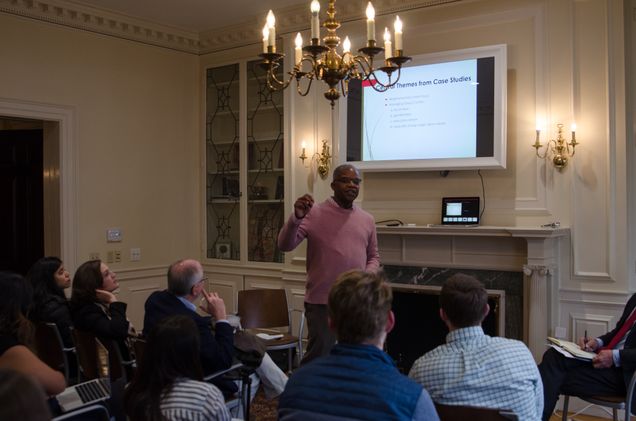Latino Mayors
Latino Mayors: Political Change in the Postindustrial City
By Carly Berke
On Thursday, November 14th, the Initiative on Cities, the Latin America Studies Program, the African American Studies Program, and the Center for Latin American Studies held a book talk with Marion Orr, the co-editor of Latino Mayors: Political Change in the Industrial City.
Orr is the Frederick Lippitt Professor of Public Policy and Professor of Political Science and Urban Studies at Brown University, where he specializes in urban politics, race and ethnic politics, and African-American politics. In Latino Mayors, which is co-edited by Domingo Morel, a former student of Orr, the authors explore the rise of Latino mayors over the past 30 years and how their ascension into politics is a reflection of ethnic succession, changing urban demography, and political contexts. The book contains case studies of 11 Latino Mayors in six cities across the United States: San Antonio, Los Angeles, Denver, Hartford, Miami, and Providence.

Orr opened his presentation by explaining the background behind the book, which was inspired by a similar project entitled African American Mayors. Orr kept African American Mayors on his office bookshelf, and he often found himself coming into a direct line of view with it when sitting down to meet with students. He began to speculate what a similar project would look like for Latino mayors, and thus invited experts and scholars from around the country to come discuss the city demographics, urban affairs, and the history behind some of these Latino leaders. Together they collaborated on a series of working papers surrounding Latino mayors and shifting city demographics. Orr emphasized that he wanted to conduct in depth case studies and take a methodological approach to help future scholars continue research in this area.
“This is foundational work; it is the first book that takes a collective look at the election and governance of Latino Mayors,” said Orr.
Orr and his colleagues studied 11 Latino mayors across the country: Frederico Peña, former mayor of Denver; Henry Cisneros, Edward Garza, and Julián Castro, former mayors of San Antonio; Alex Penelas, Carlos Alvarez, former mayors of Miami-Dade County and Carlos Giménez, the current mayor of Miami-Dade County; Antonio Villaraigosa, former mayor of Los Angeles; Eddie Perez and Pedro Segarra former mayors of Hartford, Connecticut; and Angel Taveras, former mayor of Providence, Rhode Island.
Their goal was to situate these 11 mayors within a broader historical and political context, which provides a grounding for undergraduate and graduate students in political science, urban studies, and similar disciplines and creates a foundation for future scholarship. The main argument that Orr and his colleagues explored in their work is that Latino mayors came to power in a new political, economic, and social context in American cities that European immigrant mayors in the “industrial” city and African American mayors in the “redevelopment” city did not experience.
The Mayor’s office has long been a reflection of shifting urban demographics, and ethnic and racial transitions in mayoral politics have been documented throughout American history as a component of changing city dynamics. Orr began by explaining that during the industrial period, from the 1830s to the 1930s, cities saw Irish and Italian political incorporation and ascension into the Mayor’s office. At this time in history, cities were growing at a rapid pace, and as industrialization brought new technology and more jobs to cities, they became a magnet for immigrants who were arriving during a massive influx of European immigration. In this era, the Mayor’s job focused on the provision of services and public works projects.
After the rise of the industrial city, Orr argues that African American mayors began to gain political power during the “redevelopment city”, when American cities post-WWII adapted to new factors like the automobile, suburbanization, and white flight. As African American communities began to move to urban spaces, they mobilized and organized to gain political representation, galvanizing the African American community and contributing heavily to the election of African American mayors in the ’60s and ’70s. Mayors in this time period faced new challenges in urban affairs.
“The mayor’s job starts to become much more complex than just routine provision of services,” said Orr. “They began to take an active role in fighting city decline, building highways and housing, and developing partnerships with bankers and corporate leaders to drive investment in downtown areas.”
While Latinos were not a major player in city politics during this period, they start to come into office during what Orr and his colleagues refer to as the “postindustrial” period, beginning in 1990 and continuing through the 21st century. During this period, cities have and continue to undergo economic and employment restructuring. Cities and city leaders compete for investment from multinational corporations and private business ventures, and the changing leadership structures of universities, medical centers, and nonprofit foundations has altered urban political leadership. Service-oriented organizations have become increasingly political, studying critical policy areas and attempting to influence politics and public policy. Additionally, a new class of highly-skilled workers are being drawn into city spaces, triggering gentrification and shifting labor markets.
Latino mayors coming to power in the postindustrial city experience new and extensive challenges not faced by mayors from other periods, including fiscal pressures, gentrification, and racial and economic inequality. Job growth has shifted to service-based industries and now favors highly educated workers. As the urban economy continues to undergo reconstruction, the labor market continues to shift, polarizing racial, ethnic, and socioeconomic divisions across communities and essentially ending the notion that cities are a place of growth and opportunity for immigrants. Public education has also become a primary policy goal for Latino mayors, which marks a significant shift in priorities from African American mayoral candidates during the redevelopment city, who tried to stay away from school politics, assuming it to be a contentious policy issue. But as multinational companies draw a new class of college-educated workers in business, engineering, architecture, arts, media, and entertainment to cities, access to quality public education has become a critical and principal policy concern and is consistently ranked high as a priority in Latinx public opinion polling.
Another challenge that mayors have faced in the postindustrial period, particularly in the South, West, and Southwest, are progressive reforms that put limits on mayoral authority, a challenge with which industrial-era mayors never struggled. Mayors in San Antonio, for instance, work closely with city managers, non-elected officials who maintain significant power over urban affairs. Even as several mayors run on platforms supporting education, the Mayor’s office does not often have control over education policies and services in the city. Their job has required them to develop new ways to influence local public education.
Mayors also struggle with increased fiscal pressure in the postindustrial city, as they’re forced to balance revenues with expenditures while federal rollback in social services and welfare offsets the burden onto city and state governments.
Although Orr argues in his book that racial and ethnic transition in the mayor’s office is triggered by demographic changes, he also emphasized that factors like organization and leadership have a vital role in advancing political incorporation. In his studies, he found that almost all of the Latino mayors he studied had a background in community organizing.
“When we look at these mayors, almost all of them had extensive experience and involvement in community-based organizations in the Latino community,” said Orr.
Although these mayors had real grassroots experience that served as a framework for their mayoral campaigns, Orr also discovered that the majority campaigned on what he refers to as “de-racialized campaigns”, in which candidates deemphasize their ethnicity and try to play down racial issues.
Orr provided a brief insight into one of their case studies, which looked at former Providence mayor Angel Taveras. Mayor Taveras grew up through community-based organizations, and after completing his undergraduate degree at Harvard and law degree Georgetown Law School, he returned to Providence and ran for a Congressional seat in 2004. Although he lost the election, he discovered that he performed well in Providence’s precincts, and he decided to run for mayor.
According to Orr, Mayor Taveras ran on a deracialized campaign that focused on education. During his tenure, one of his primary challenges was addressing the fiscal concerns that burdened Providence. In his first year he faced a structural deficit of $70 million, which grew by $40 million in the following year. Mayor Taveras was forced to make hard decisions to make ends meet, including asking retirees to give up a small fraction of their pension budget.
“Once you get into the office, especially as Mayor, you begin to realize the important role that the corporate economic community plays, so that the governing coalition begins to look much different than your electoral coalition,” said Orr. Sometimes there are high expectations for a Mayor, followed by disappointment when fiscal and economic challenges restrain the Mayor from advancing reforms.
But Orr and his colleagues argue that Mayor Taveras and other Latino mayors in the postindustrial city are better equipped for public office after their work in community organizing. Mayor Taveras’ background experience in organizing and reconciling different interests in the Latinx community enabled him to step into the role of mayor and work to build bridges across different communities and interests.
“Latinx mayors, like Mayor Taveras, might be better equipped than previous mayors to handle conflict, especially in communities where you have a diverse Latinx community,” said Orr.
Today, 67% of elected Latino officials serve at the municipal level on school boards, city councils, and country commissions, as mayors, and in other local elected offices. In sum, Orr demonstrated how the ascension of Latinos into mayoral politics is a reflection of changing urban demographics and contexts, and that the challenges they face in the postindustrial city vary greatly than those faced by mayors in the industrial and redevelopment city.
